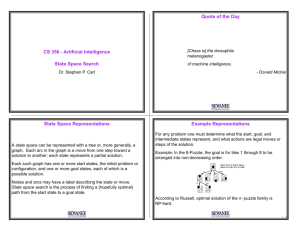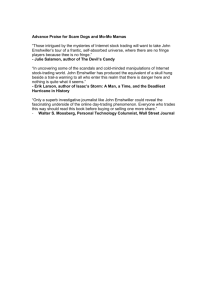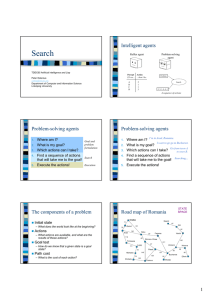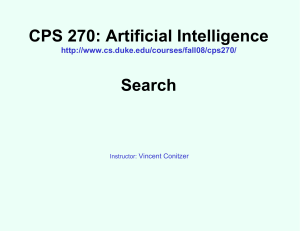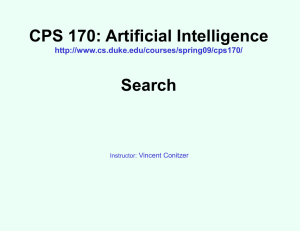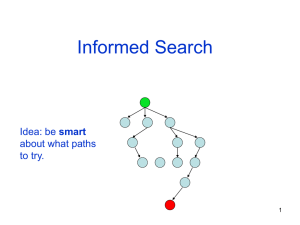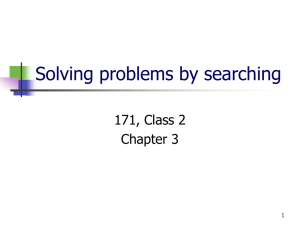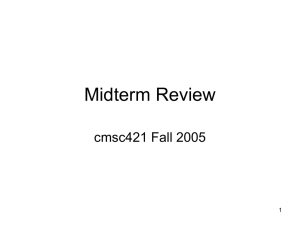Goal state
advertisement
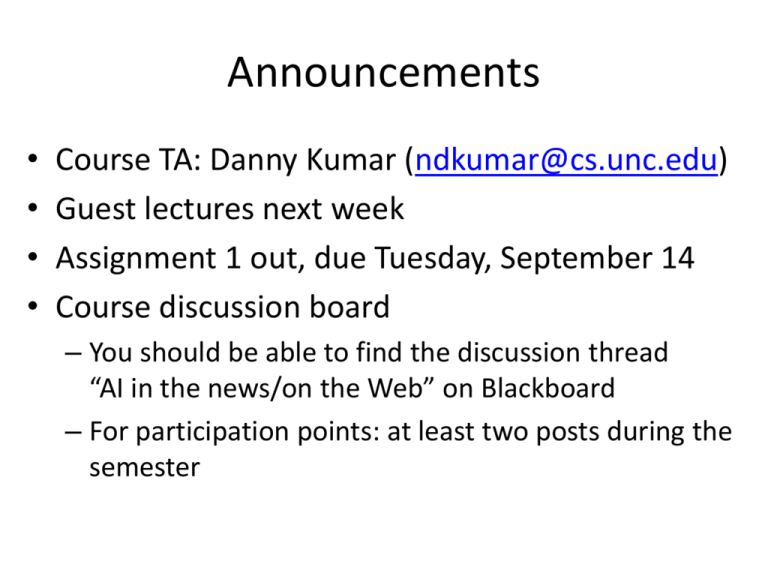
Announcements • • • • Course TA: Danny Kumar (ndkumar@cs.unc.edu) Guest lectures next week Assignment 1 out, due Tuesday, September 14 Course discussion board – You should be able to find the discussion thread “AI in the news/on the Web” on Blackboard – For participation points: at least two posts during the semester Solving problems by searching Chapter 3 Search • We will consider the problem of designing goalbased agents in observable, deterministic, discrete, known environments • Example: Start state Goal state Search • We will consider the problem of designing goalbased agents in observable, deterministic, discrete, known environments – The solution is a fixed sequence of actions – Search is the process of looking for the sequence of actions that reaches the goal – Once the agent begins executing the search solution, it can ignore its percepts (open-loop system) Search problem components • Initial state • Actions • Transition model Initial state – What is the result of performing a given action in a given state? • Goal state • Path cost – Assume that it is a sum of nonnegative step costs Goal state • The optimal solution is the sequence of actions that gives the lowest path cost for reaching the goal Example: Romania • On vacation in Romania; currently in Arad • Flight leaves tomorrow from Bucharest • Initial state – Arad • Actions – Go from one city to another • Transition model – If you go from city A to city B, you end up in city B • Goal state – Bucharest • Path cost – Sum of edge costs State space • The initial state, actions, and transition model define the state space of the problem – The set of all states reachable from initial state by any sequence of actions – Can be represented as a directed graph where the nodes are states and links between nodes are actions • What is the state space for the Romania problem? Example: Vacuum world • States – Agent location and dirt location – How many possible states? – What if there are n possible locations? • Actions – Left, right, suck • Transition model Vacuum world state space graph Example: The 8-puzzle • States – Locations of tiles • 8-puzzle: 181,440 states • 15-puzzle: 1.3 trillion states • 24-puzzle: 1025 states • Actions – Move blank left, right, up, down • Path cost – 1 per move • Optimal solution of n-Puzzle is NP-hard Example: Robot motion planning • States – Real-valued coordinates of robot joint angles • Actions – Continuous motions of robot joints • Goal state – Desired final configuration (e.g., object is grasped) • Path cost – Time to execute, smoothness of path, etc. Other Real-World Examples • • • • • Routing Touring VLSI layout Assembly sequencing Protein design Search • Given: – – – – – Initial state Actions Transition model Goal state Path cost • How do we find the optimal solution? – How about building the state space and then using Dijkstra’s shortest path algorithm? • The state space is huge! • Complexity of Dijkstra’s is O(E + V log V), where V is the size of the state space Tree Search • Let’s begin at the start node and expand it by making a list of all possible successor states • Maintain a fringe or a list of unexpanded states • At each step, pick a state from the fringe to expand • Keep going until you reach the goal state • Try to expand as few states as possible Search tree • “What if” tree of possible actions and outcomes • The root node corresponds to the starting state • The children of a node correspond to the successor states of that node’s state • A path through the tree corresponds to a sequence of actions – A solution is a path ending in the goal state • Nodes vs. states – A state is a representation of a physical configuration, while a node is a data structure that is part of the search tree Starting state Action Successor state … … … … Goal state Tree Search Algorithm Outline • Initialize the fringe using the starting state • While the fringe is not empty – Choose a fringe node to expand according to search strategy – If the node contains the goal state, return solution – Else expand the node and add its children to the fringe Tree search example Tree search example Tree search example Fringe Search strategies • A search strategy is defined by picking the order of node expansion • Strategies are evaluated along the following dimensions: – – – – Completeness: does it always find a solution if one exists? Optimality: does it always find a least-cost solution? Time complexity: number of nodes generated Space complexity: maximum number of nodes in memory • Time and space complexity are measured in terms of – b: maximum branching factor of the search tree – d: depth of the least-cost solution – m: maximum length of any path in the state space (may be infinite) Uninformed search strategies • Uninformed search strategies use only the information available in the problem definition • • • • Breadth-first search Uniform-cost search Depth-first search Iterative deepening search
